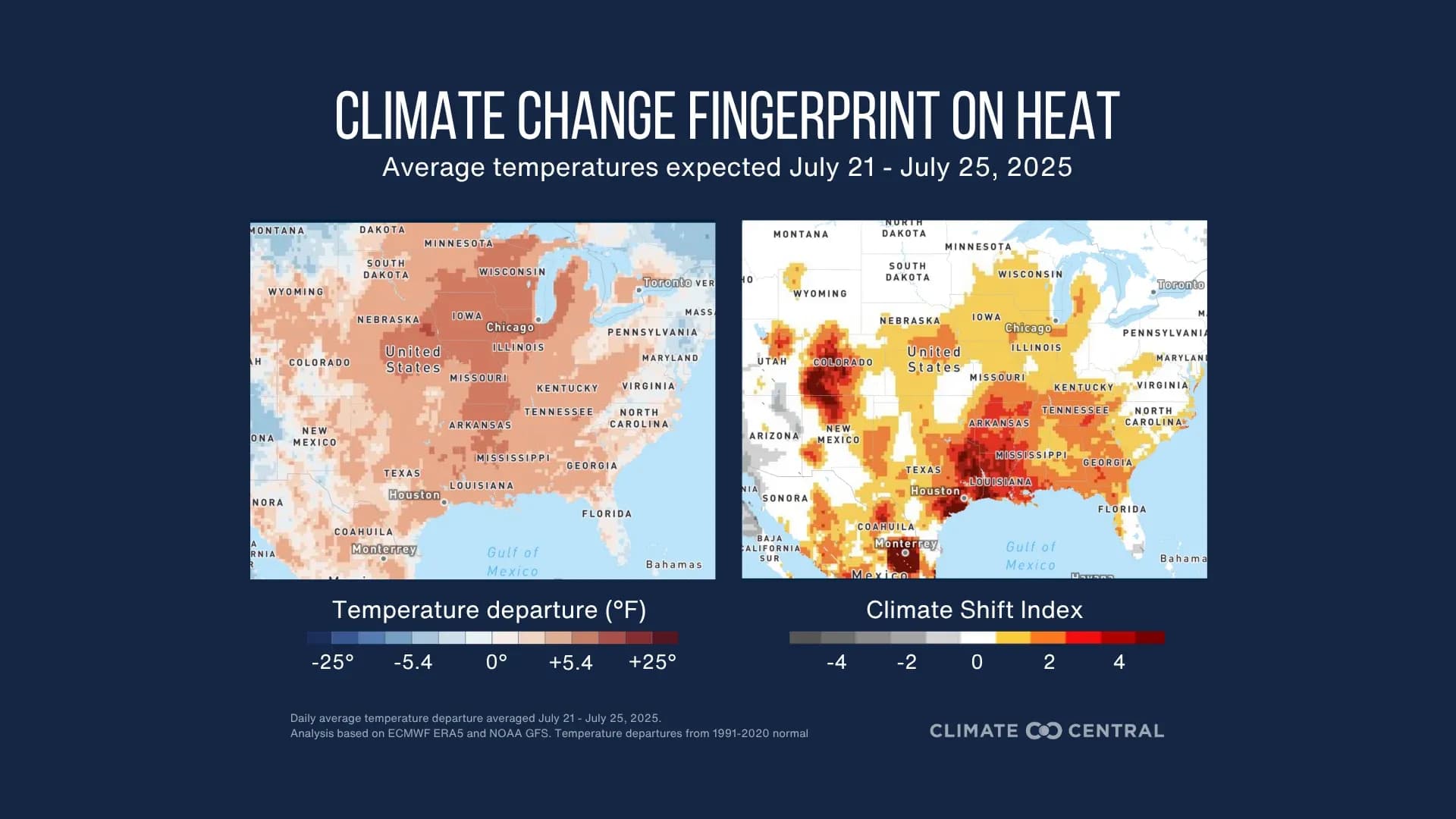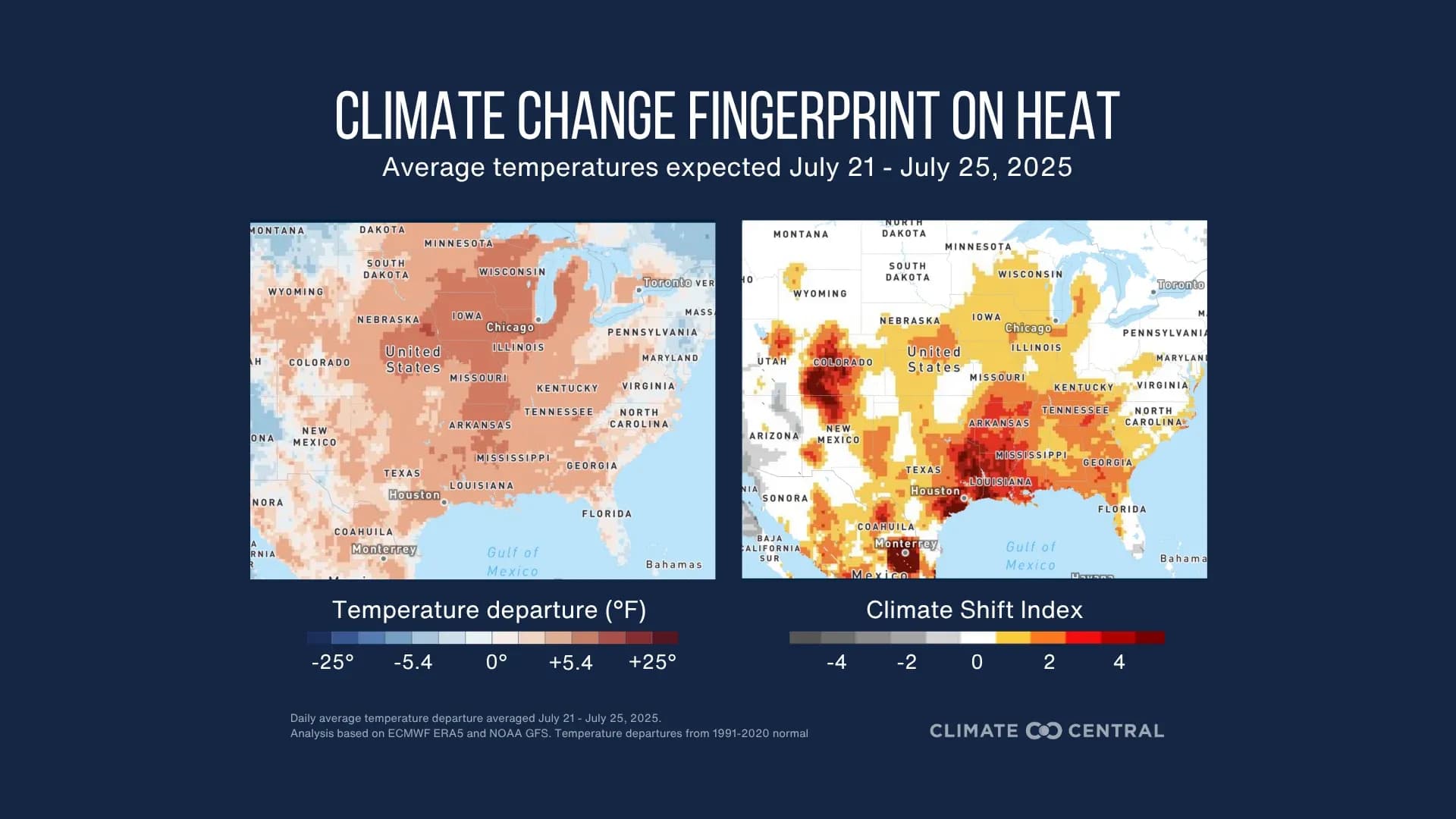The Enduring Burn: Unmasking Climate's Mark on America's Hottest Days
Unpack America's climate-amplified heatwave. Discover how the Climate Shift Index reveals humanity's fingerprint on extreme temperatures and what it means for our future summers.
The Grip of the Unseen Heat Dome
America is bracing for a truly brutal stretch of summer heat, not just a typical July sizzle. From July 21st to 25th, an expansive, unusually hot, and humid air mass is set to blanket a significant portion of the . What began as a sweltering weekend in the Southeast is forecast to creep into the mid-South early in the week, eventually engulfing the Midwest by mid-to-late week. This intense weather pattern is anchored by a formidable heat dome, a strong area of high pressure that acts like a lid, trapping and funneling hot, humid air northward and northeastward. Forecasts paint a stark picture: triple-digit highs are expected for days on end across , , , northern , , and . Even the lower Midwest and Northeast could see temperatures soaring into the mid-to-upper 90s. The real danger, however, comes from the oppressive humidity, particularly in the Central Plains, Midwest, and the Mississippi and Ohio valleys, where heat index values could skyrocket to a life-threatening 105°F to 110°F. What’s more, the nights won't offer much relief, with unusually warm overnight lows in the mid-70s to low 80s—a staggering 5°F to 15°F above average—threatening to break record high minimums across many Southern and Midwestern states. This isn't just a hot spell; it's a pervasive, dangerous heat event.
Decoding the Climate Shift: What CSI Tells Us
To truly grasp the significance of this heat, we need to look beyond mere temperature readings and understand the invisible hand of climate change. This is where the comes into play. Developed with peer-reviewed methodology and real-time data, CSI provides a crucial estimate of how human-caused climate change has increased the likelihood of a particular daily temperature. For the current heat wave, a analysis reveals a chilling reality: this excessive heat has been made at least three times more likely for nearly 160 million people across the U.S. That's almost half the nation's population experiencing a direct, quantifiable influence from our changing climate. Across wide swaths of the country, from and to and , CSI levels are forecast to hit 5 – the highest possible, meaning human-caused climate change has made this extreme heat at least five times more likely. As , VP of Science at Climate Central, powerfully states, “This is not your grandmother’s heat wave. Yes, July is usually a hot month, but climate change is making this heat wave significantly hotter — and therefore more dangerous — than heat waves of the past.” This isn't just a naturally occurring meteorological event; it's a climate-amplified one.
Beyond the Numbers: Life in a Climate-Amplified Summer
While the scientific metrics of CSI levels and temperature forecasts are vital, the true impact of a climate-amplified summer is felt in the daily lives of millions. When triple-digit highs combine with suffocating humidity, pushing heat index values into the 105°F to 110°F range, it transforms typical summer discomfort into a profound health and safety crisis. Imagine living through days where the air itself feels like a physical weight, where outdoor work becomes perilous, and even indoor spaces without adequate cooling offer little sanctuary. The relentless nature of this heat, particularly the unusually warm overnight lows, is especially insidious. When temperatures remain in the mid-70s to low 80s through the night, the human body has no opportunity to cool down and recover from the day's extreme stress. This lack of nocturnal relief significantly elevates the risk of heat-related illnesses and fatalities, making the event far more dangerous than historical heat waves. This isn't just about a few hot days; it's about a prolonged, inescapable siege of heat that disproportionately affects vulnerable populations and strains infrastructure. It’s a vivid demonstration of what it means to live in an era where 'unnatural disasters' are becoming the norm.
Navigating the New Normal: Preparedness and Perspective
As climate change continues to reshape our weather patterns, these climate-amplified heat events are no longer anomalies but rather a harsh new normal we must confront. Understanding this shift demands a fresh approach to how we prepare for and report on such 'unnatural disasters.' The insights provided by tools like the are critical, offering the public and decision-makers a clear, scientific link between human activity and the intensity of the weather we experience. This isn't about fear-mongering; it's about informed action. For individuals, this means taking extreme heat warnings far more seriously, understanding the dangers of high heat index values, and prioritizing hydration and cool environments. For communities, it requires robust public health strategies, accessible cooling centers, and infrastructure resilience. Journalists and communicators, too, play a vital role in contextualizing these events, moving beyond simple temperature reports to explain the underlying climate drivers and their implications. As this current heat wave is likely to extend beyond its initial forecast, it serves as a stark reminder that we are living through a profound atmospheric transformation. Embracing this new perspective, armed with better data and a commitment to preparedness, is our only path forward in a world where the enduring burn of climate change is increasingly palpable.
Related Articles

The Climate Crucible: Unpacking the New Era of Extreme Summer Heat

The Climate Crucible: Unpacking the New Era of Extreme Summer Heat

Unpacking Summer's Fiery Future: How Climate Change Rewrites the Rules of Heat

Unpacking Summer's Fiery Future: How Climate Change Rewrites the Rules of Heat

Beyond the Thermometer: Unpacking Our New Era of Extreme Heat

Beyond the Thermometer: Unpacking Our New Era of Extreme Heat

The Invisible Shift: When Summer's Embrace Becomes a Harsh Grip
